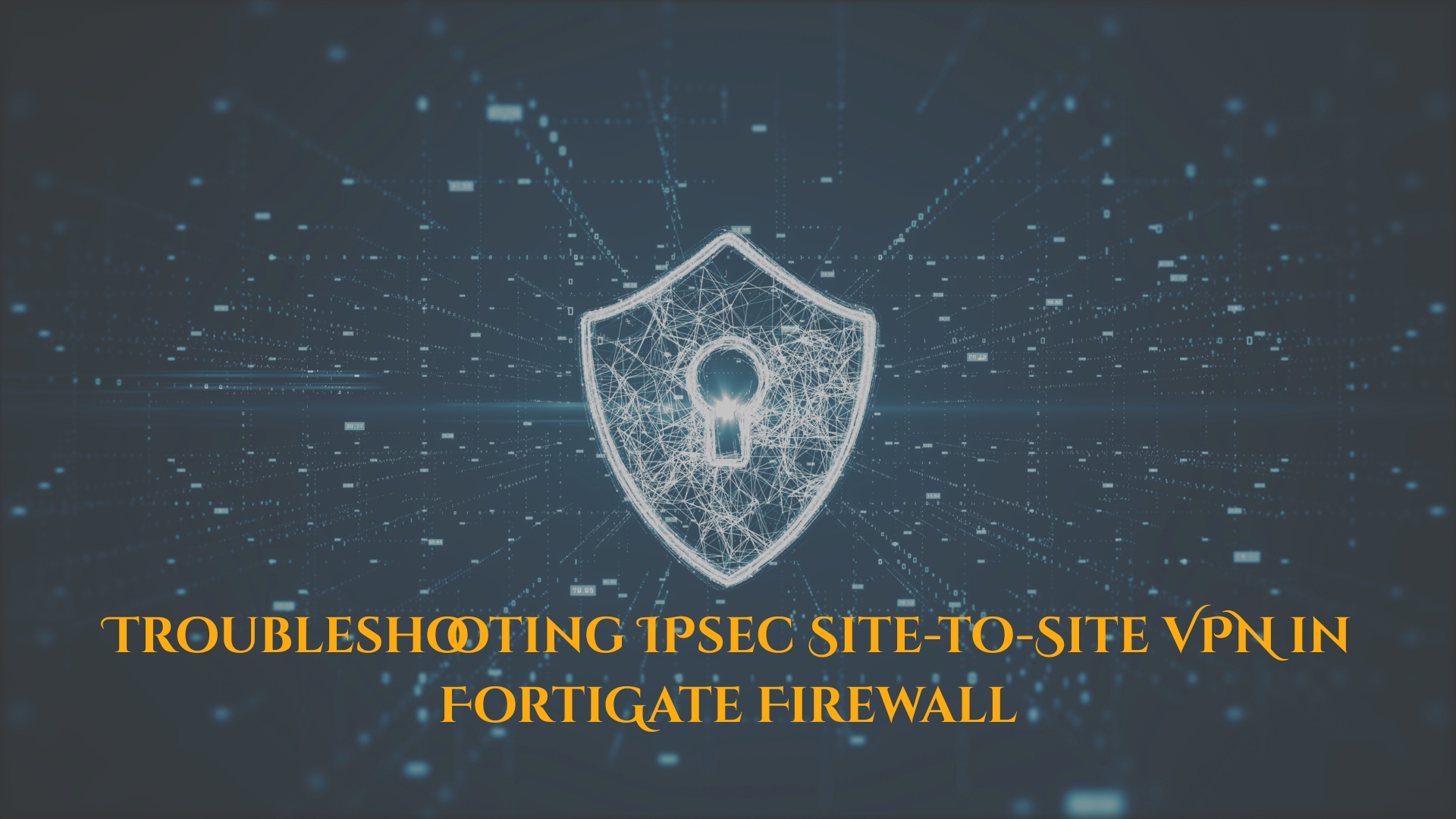
Troubleshooting IPsec VPN Site-To-Site Connections in Fortigate Firewall
Troubleshooting IPsec VPN Site-To-Site Connections in FortiGate Firewall
Ensuring the robust operation of secure network connections is paramount for any enterprise. This article delves into the critical process of troubleshooting IPsec VPN site-to-site connections on FortiGate firewalls, providing detailed insights and practical steps to maintain seamless and secure communication channels.
Understanding IPsec VPN
A thorough understanding of IPsec VPNs is fundamental for effective troubleshooting. This section will elaborate on the core principles and components that comprise these vital secure tunnels, emphasizing their role in safeguarding enterprise data.
What is IPsec?
IPsec, or Internet Protocol Security, is a suite of protocols that provides cryptographic security for IP networks. It is a critical component for establishing secure VPN tunnels, ensuring data confidentiality, integrity, and authenticity across untrusted networks. This framework allows organizations to create encrypted connections between various sites, protecting sensitive information from unauthorized access and tampering.
Components of an IPsec VPN
An IPsec VPN is comprised of several key components that work in concert to establish a secure VPN tunnel. These include Phase 1 (Internet Key Exchange – IKE), responsible for establishing a secure channel for the exchange of cryptographic keys, and Phase 2 (IPsec Security Association – SA), which defines the actual parameters for encrypting and encapsulating the user traffic through the VPN tunnel. Understanding these distinct phases is crucial for effective troubleshooting IPsec VPN issues.
Importance of VPN Tunnels
VPN tunnels are indispensable for modern enterprises, providing secure conduits for data exchange between geographically dispersed locations. They enable secure access to internal resources for remote users and facilitate encrypted communication between various network segments. The integrity and reliability of these VPN tunnels are directly linked to an organization’s operational continuity and data security posture.
Configuration of FortiGate IPsec VPN
Initial Setup Steps Site to Site VPN tunnel
To initiate the configuration of a FortiGate IPsec VPN, the initial setup steps for a site-to-site VPN tunnel are crucial. This involves defining the remote and local subnets, selecting the appropriate interface for the VPN connection, and ensuring that the FortiGate firewall is properly licensed and updated. These foundational steps ensure that the network environment is prepared for the secure VPN tunnel, laying the groundwork for robust IPsec VPNs.
Defining VPN Tunnel Parameters
Defining the VPN tunnel parameters involves specifying critical settings for both Phase 1 and Phase 2. For Phase 1, this includes selecting the IKE version, authentication method (pre-shared key or digital certificates), encryption algorithms (e.g., AES256), and Diffie-Hellman group. For Phase 2, the parameters encompass defining the IPsec SA lifetime, protocols (ESP/AH), and the perfect forward secrecy (PFS) group. Accurate parameter definition is vital for successful IPsec VPN tunnel establishment.
Configuration using CLI Commands
While the FortiGate GUI offers a user-friendly interface, configuring the IPsec VPN using CLI commands provides granular control and can be essential for advanced scenarios or automation. Commands like `config vpn ipsec phase1-interface` and `config vpn ipsec phase2-interface` allow precise definition of all VPN parameters, including peer IP, pre-shared key, proposals, and selectors. This method is particularly useful for troubleshooting IPsec VPNs as it reveals the exact configuration.
Troubleshooting IPsec VPN Issues
Common IPsec VPN Problems
Common IPsec VPN problems often stem from mismatches in Phase 1 and Phase 2 parameters, incorrect firewall policy configurations, or routing issues preventing traffic from reaching the VPN tunnel. These can manifest as a failure to establish the IPsec SA, intermittent connectivity, or a complete inability to pass VPN traffic. Understanding these prevalent issues is the first step in effective troubleshooting IPsec VPN site-to-site connections.
Utilizing FortiGate Debug Commands
FortiGate offers a suite of powerful debug commands indispensable for IPsec VPN troubleshooting. Commands such as `diagnose vpn ike log-filter` and `diagnose debug application ike -1` provide detailed insights into the IPsec negotiation process, showing errors during Phase 1 and Phase 2. Additionally, `diagnose vpn tunnel list` helps check the status of the IPsec tunnel, offering a real-time view of its operational state.
Troubleshooting Invalid ESP Packets
Invalid ESP packets often indicate a mismatch in Phase 2 parameters, such as encryption algorithms or keys, or Network Address Translation (NAT) traversal issues. To troubleshoot invalid ESP packets, utilize `diagnose debug flow` to trace packet paths and `diagnose vpn ike log-filter dst-addr4` to inspect ESP packet exchanges. Verifying the IPsec SA status with `diagnose vpn ipsec sa` can also help identify discrepancies, ensuring the integrity of the VPN connection.
Checking VPN Connection Status
Verifying Tunnel Status
Verifying the status of your IPsec VPN tunnel is a critical first step in troubleshooting any connectivity issues on your FortiGate firewall. To check the FortiGate IPsec tunnel status, navigate to the “IPsec Monitor” section within the FortiGate GUI, which provides a real-time overview of all active IPsec SAs and their current operational state. Alternatively, using the following CLI commands like `diagnose vpn tunnel list` and `diagnose vpn ike log-filter` can provide more granular details about the IPsec SA and negotiation process for the IPsec VPN tunnel. This helps confirm whether the Phase 1 and Phase 2 security associations are established, ensuring the VPN connection is active.
Inspecting VPN Logs
Inspecting VPN logs is paramount for comprehensive IPsec VPN troubleshooting in FortiGate. The `diagnose vpn ike log-filter` CLI command allows you to filter logs specifically for IPsec VPN events, providing detailed insights into Phase 1 and Phase 2 negotiations, including any errors or mismatches that prevent the IPsec tunnel from coming up. These logs are invaluable for identifying common IPsec VPN problems such as incorrect pre-shared keys, mismatched Phase 1 proposal parameters, or issues with IPsec SA establishment. Analyzing these logs systematically aids in efficient troubleshooting IPsec VPNs.
Consult FortiGate Documentation
Consulting the FortiGate documentation is an indispensable resource for troubleshooting IPsec VPN issues, particularly when encountering complex or persistent problems. The official FortiGate documentation provides comprehensive guides, best practices, and detailed explanations of various IPsec VPN configuration scenarios and troubleshooting steps specific to the FortiGate firewall. It often includes examples of CLI commands, typical error messages, and their resolutions, which can significantly expedite the process of resolving IPsec VPN problems and ensuring the stability of your FortiGate device and the IPsec connection.
Advanced Debugging Techniques
Using Debugging Tools for IPsec VPN
For advanced IPsec VPN troubleshooting in FortiGate, leveraging dedicated debugging tools is essential. Commands such as `diagnose debug application ike -1` enable extensive logging of the IKE daemon, offering deep insights into the IPsec phase negotiation. This level of detail helps pinpoint specific failures during Phase 1 and Phase 2, such as authentication failures or proposal mismatches, which are common IPsec VPN problems. These debugging tools are indispensable for understanding the intricate workings of the FortiGate IPsec VPN and ensuring robust VPN configuration.
Analyzing Traffic Flow
Analyzing traffic flow is a critical step in troubleshooting IPsec VPN issues, especially when the VPN tunnel appears to be up but no traffic is passing through the VPN. Utilizing `diagnose debug flow` on the FortiGate firewall allows you to trace packets from their source to destination, revealing if they are being correctly encapsulated, decrypted, or dropped. This helps identify firewall policy misconfigurations, routing issues, or network address translation (NAT) problems that prevent VPN traffic from flowing through the IPsec tunnel, ensuring seamless data exchange.
Identifying Configuration Errors
Identifying configuration errors is often the most challenging aspect of troubleshooting IPsec VPNs. Common errors include mismatches in Phase 1 and Phase 2 proposal parameters (e.g., encryption algorithms, authentication methods, Diffie-Hellman groups), incorrect local or remote subnets, or misconfigured firewall policy rules that block VPN traffic. Carefully reviewing the entire IPsec VPN configuration on both ends of the FortiGate IPsec connection, comparing Phase 1 and Phase 2 settings, and cross-referencing with network diagrams are crucial steps to ensure the integrity of the IPsec VPN tunnel.

![[CIVN-2025-0353] Multiple Vulnerability in CISCO](https://teamwin.in/wp-content/uploads/2025/06/certin-new-e1751351599950-500x383.png)


